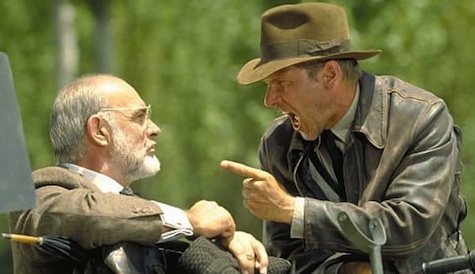This is one of those opinions that is probably going to get me hauled out to face some sort of tribunal under charges of blasphemy. See, when it comes to Indiana Jones, most hardcore fans will say it’s Raiders, obviously. Raiders of the Lost Ark is the best Indiana Jones film, the only one that matters, and for the most part, I completely understand why. It’s our introduction to a beloved pop culture hero, Harrison Ford is a handsome dog in it, the fedora, the whip, Karen Allen being awesome, plus America has only recently gotten over its love affair with beating up Nazis in every WWII-era film it puts out. (Although considering last year’s Inglorious Bastards, it might appear that we haven’t gotten over it at all.)
But I’m going to say it: I don’t think it’s the best Indiana Jones film. I think that award goes to The Last Crusade.
Before everyone starts throwing old shoes and rotten fruit my way, let’s talk about it. Because, you know, it’s incredibly easy to say that the movie that begins a series is the best, especially where cult classics are concerned. The first film is the first time you see the characters you love in action. The first film sets the tone for the rest and establishes rules for the fictional universe. The first film introduces you to the musical and visual themes that you come to associate with those stories. It gives you all the cues you require to appreciate potential sequels in the first place.
So we often like first films the best. If you did a general census and had fans checking boxes, most of them would tick Raiders, Back to the Future I, the first Matrix film, and so on. But just because those movies are essential to our understanding and enjoyment of further installments doesn’t automatically make them the best. What makes Last Crusade special enough to top my list, then? Observe….
The opening of Raiders introduces us to Indiana Jones in a surprisingly distant way. We don’t even see our hero’s face for the first few minutes, and when we finally do, it’s because he’s whipped a gun out of the hand of a man about to kill him. And that’s pretty badass. There’s no reason to repeat it. So when The Last Crusade opens, we’re given a different sort of introduction: A “Formation of the Hero” sequence. This flashback has a sort of whimsical, mythic quality; everything about Indy gets explained in one go, from his fear of snakes to his love of fedoras to the scar on Harrison Ford’s chin. It’s daring in its decision to put everything up front and make Indy more of a legend, with a defining moment of construction.
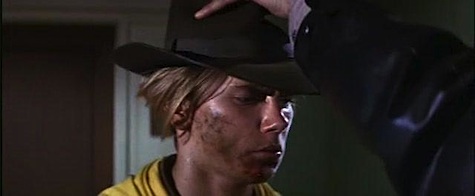
“You lost today, kid. But that doesn’t mean you have to like it.” That’s what the man in the hat says to teenaged Indy, and don’t those words basically guide his life from that point on?
Indiana Jones has always had a lot more to offer than your average “action movie with fantastical elements,” and I attribute a lot of that to its sense of humor. It’s as though Harrison Ford got to take all the parts of Han Solo he liked, and then was free to add his own lack of levity to the situation. The Last Crusade perfects that sense of humor, allows us to revel in how admittedly ridiculous this universe is, a place where all religions, all supernatural happenings, all parts of history can collide however they see fit for the sake of a globetrotting romp. Indy’s Scottish accent is appalling, he still can’t manage to pick a disguise that fits him, and his frequent bickering with Papa Jones, Sr. is a marvel (that I will get to in a moment).
If Indiana Jones is being constantly compared to James Bond—which was part of the reason Connery was cast to play his dad in the first place—then Last Crusade goes out of his way to prove just how badly Indy lives up to that sort of mantle. He lets a nasty lady get too close and pays the price, he brings hapless friends on the journey who make everything more difficult for him, he ends up working for the bad guy by accident, he gets noticed everywhere he goes, and worst of all, he cares. Indiana Jones has far too much heart to be the iceman with a pistol, knocking back martinis and offering glib retorts to bad men.
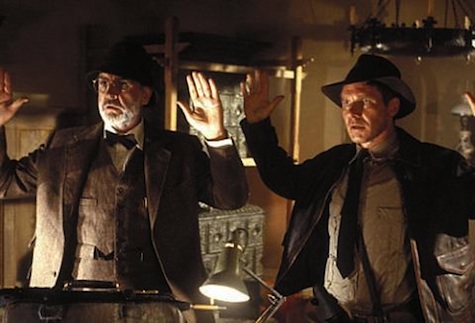
Steven Spielberg has spent nearly his entire career picking apart bad father-son dynamics, and though it grates at times, The Last Crusade is one of the places where it works to an utterly charming end. Ford and Connery form a super team that needed to occur on screen, and the film chooses not to spend the bulk of the narrative angsting over past wrongs between them. Instead, we see a lot of exchanges that remind us of how we interact with our own parents, moments of utter exasperation, communication meltdowns, pride paired with shock, and the protectiveness that overwhelms on both sides of that relationship.
Spielberg was a more experienced director by the third Indy film and it shows. Raiders and Temple of Doom both have places where the pace suddenly slows and the narrative fizzles out: Either actions scenes go on for just a minute or two longer than they should, or too much talking gets in the way of important things that need to get done. The Last Crusade has very few drags; many cuts from one scene to another impart a joke of some kind, from Brody in the market in Iskenderun to Sallah returning with camels instead of horses. There are plenty of smaller obstacles to overcome on the gang’s way to the giant MacGuffin, and that keeps the whole story fast on its feet.
Some of the most famous Indy lines come from this film, which is rare for a sequel. “No ticket” is an obvious favorite, along with “The Ark of the Covenant” “Are you sure?” “Pretty sure,” but nothing in any of the other films can match up to the whole “you are named after the dog” fiasco.
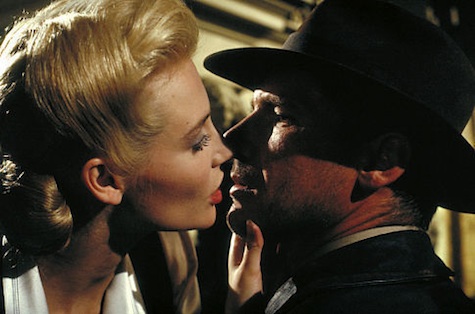
We get a lot of moments that mirror Raiders of the Lost Ark, but offer different outcomes. In that way, the third film pays homage to everything we enjoyed about Raiders, but gives closure in some places and more bang for our buck in others: Indy gets the artifact he’s been searching for in the film’s opening this time around, the odd benefactor of the Grail expedition is actually integral to the plot, we see more of Marcus and Sallah, and Indy has a fling that doesn’t go so well for him. (You could almost call it his comeuppance for whatever he did to Marion when they were young.) The Nazis are as odious as ever, but treated with perhaps even a bit more tongue-in-cheek this time around, turning them into classic supervillains for Indy to battle each time they reemerge. The final showdown builds with each step of the challenge, and the danger of the quest is much more immediate with Henry Jones’ life on the line.
Instead of fearing the awesome Power of God, Indiana Jones walks away with newfound knowledge and a deep realization of what is precious to him. (Which is to say, this time we tackled New Testament God rather than Old Testament God.) The Last Crusade retreads material by altering it and offering something new to take away from it. If you’re going to rehash, doing it so intentionally and meticulously is a welcome way to go about it. It isn’t copying, but rather, refining. It’s like the difference between blanco and reposado tequila.
And it’s always tickled me that Indy uses his skills as an archaeologist to figure out which cup is the true Grail. That sort of never happens in the other films.
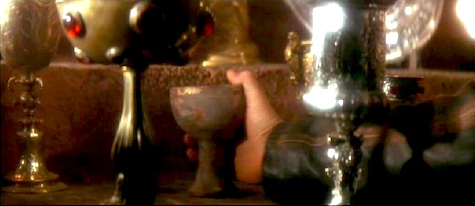
So I understand why Raiders is loved the world over, but it’s not the one that gets the most play in my house. Whenever I’m in the mood for Indiana Jones, I want to be thoroughly entertained, and Indiana Jones and the Last Crusade is the film that manages that far easier than the rest. I mean, the whole thing finishes off with a literal ride into the sunset. For a film that clearly sets out to make Indiana Jones his own legend, it does so in every sense of the word.
This post originally appeared on Tor.com on August 21, 2012.
Emmet Asher-Perrin saw The Last Crusade when she was 3 years old, and tried to explain the whole plot to her godmother… while the poor woman was being driven to the hospital to give birth. You can bug her on Twitter and read more of her work here and elsewhere.










